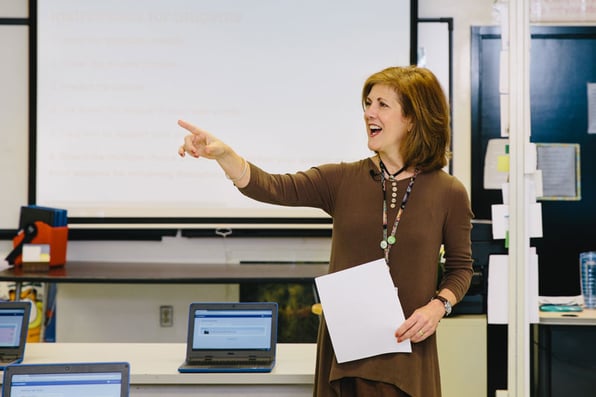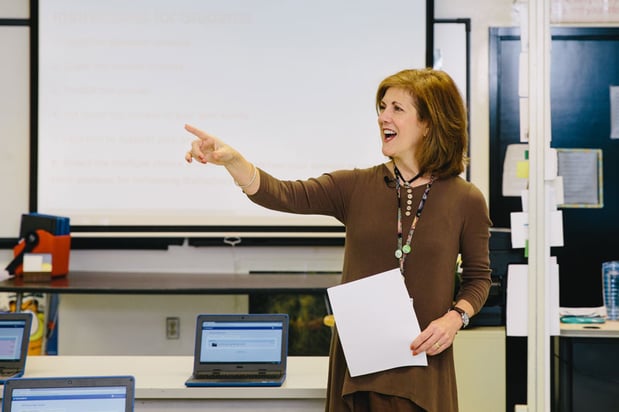
The Best Test Prep? It's Great Instruction Every Day
Use these classroom strategies to prepare students for standardized tests

As an educator, there are many targeted tactics you can take to help your students boost their testing performance. Oftentimes, however, these strategies get pushed to the end of a school year, when testing season is already in full bloom.
Research shows that real-time feedback and peer-to-peer discussion or debate lead to growth on assessments. But our classrooms must first be designed to promote these instructional best practices, and our students must have ample practice employing such test-taking skills.
By looking at test preparation as a full-year strategy, we can help our students fully develop the skills that are crucial to standardized test success.
In order to help your students improve their test performance and increase their aptitude as critical thinkers, make a conscious effort to employ the following practices in your classroom throughout the school year:
Be consistent with your terminology across disciplines as students encounter texts
Students work through similar tasks across disciplines, but educators often use varied language to build skills within those tasks. For example, a math teacher may say, “explain your answers and show your work,” whereas a science teacher may say, “support your claim with evidence.” Using a common framework, like CERCA, will help students understand that disciplines share these core skills. This comprehension will help students connect ideas and take ownership of their learning.
Educators across disciplines can put CERCA to work in their classrooms by instructing students to make a CLAIM, support that claim with EVIDENCE, explain their REASONING, identify COUNTERARGUMENTS, and use AUDIENCE-appropriate language. The University of Chicago found that the most important thing educators can do to prepare students for colleges and careers is improve and increase writing across the disciplines. We believe common frameworks significantly enhance students’ abilities to do so.
Develop higher order thinking skills in your students through rigorous instruction
Peer discussion is a critical factor in improving reading performance, according to research from the National Assessment of Educational Progress. We want our students to build knowledge depth. In order to do this, we must have students engaging in close readings of complex texts. Moreover, our lessons need to teach students how to approach text analysis, as opposed to using question-and-answer drills or practice tests as test preparation.
There are several research-based strategies we recommend employing to develop higher order thinking in your students. These include:
- Train students in error analysis. Students learn to identify the distractors presented in answer options on standardized tests.
- Show your students how to use prediction strategies. For instance, a prediction strategy would work when students have the text in front of them and can find the answer in the text before they look at the multiple choice answer options.
- Encourage annotations, particularly as a practice when it comes to assessments. You can help your students by giving them a key for annotation—maybe an underline means “main idea” and circling means “supporting details.”
Ensure students work on leveled materials
Qualitative and quantitative measures are essential for assessing what's right for each reading level. Factors such as the knowledge capital a student brings (understanding developed in the course of every-day life) and the technical complexity of materials (such as sentence length and word repetition) influence students’ interest and ability to grapple with a piece. Therefore, educators should aim to use leveled texts that allow students at different levels of readiness to contribute relevant perspectives to the same classroom discussions.
In a traditionally-arranged classroom, it may be difficult to leverage leveled materials. Therefore, educators should consider alternative layouts that promote rapid teacher feedback. A classroom layout that effectively uses technology, space, and grouping allows students to move fluidly between independent, self-paced, collaborative, and direct instruction options.
Encourage communication and debate among students in the classroom
Just as classroom layouts help educators deliver leveled materials and lessons to students, blended learning environments also improve student-to-student communication. Centering your lessons around classroom discussion and debate will ensure students develop skills that help them to think critically, both during their standardized testing and in future life tasks.
Every teacher strives to create an atmosphere that encourages student achievement. Employing these tactics in your classroom won't just help students perform better on standardized tests; they will better prepare students to lead a successful, critically-thinking life post-exams.
Learn more by watching our webinar, "Tackling Spring Assessments Through Great Instruction Every Day"

Elizabeth Riley Boyer is an experienced journalist, digital content strategist, and operations manager. Prior to joining ThinkCERCA, she was part of the founding team at Impact Engine, Chicago’s first social impact investment fund and accelerator. As Impact Engine’s Director of Operations & Communications, Elizabeth oversaw the company’s overall processes, day-to-day planning and finances, curriculum development, marketing strategy, and community outreach.
Elizabeth also spent three years at Chicago magazine, most recently as its Digital Engagement Editor, where she managed the organization’s social media and reader engagement initiatives. Elizabeth also works as a freelance content strategist, writer, and communications consultant. Her recent writings on impact entrepreneurship have been featured by the Huffington Post and Crain’s Chicago Business.
In 2007, Elizabeth helped open a private school for underprivileged children while volunteering for a nonprofit organization in the Dominican Republic. This experience inspired her to quit a paper-pushing job at an insurance brokerage firm to pursue a master’s degree in journalism from Northwestern University. Elizabeth also holds a bachelor’s degree in American studies from the University of Texas at Austin.

